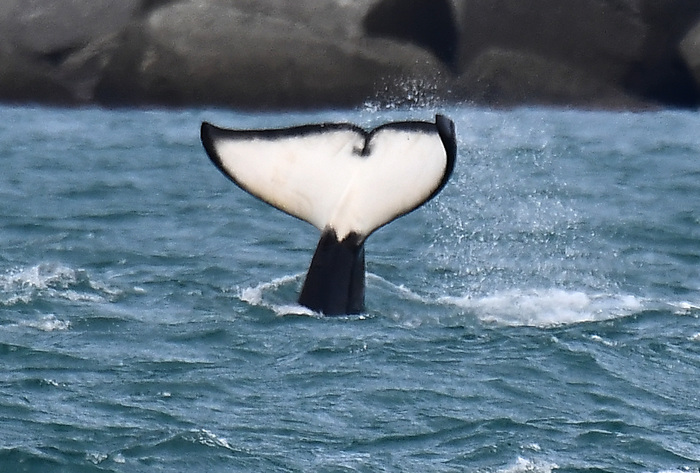The big fish doesn't always eat the small fish.
Until about three million years ago, the king of the seas was the megalodon (
Carcharocles megalodon
), an enormous shark up to 20 meters long
.
But something happened then that it became extinct, leaving its crown to the great white shark (
Carcharodon carcharias
).
Some theories blame climate cooling for the extinction.
Others point to the decline of their main prey, the whales.
A third group of scholars points to the appearance of new competitors for resources, such as the first ancestors of the killer whales.
But analysis of the teeth of large fish from the past and present now raises another possibility: Great white and megalodon sharks competed for the same food, and the former won.
The megalodon was the largest shark that ever lived.
Compared to him, the great white, at six meters, is a minnow.
For another comparison, megalodon teeth were about 10 times larger.
In those teeth may be the key to the replacement of one by the other.
A group of researchers has used an original system to find out where both animals were in the food chain.
The trophic level indicates the position of a species in the ecosystem.
To find out this position, they studied the presence and concentration of a zinc isotope in the enamel of the sharks' teeth.
Isotopes are variations of the same chemical element, in which the number of neutrons in the atomic nucleus changes.
In this case, they focused on the isotope Zn-66.
It is so stable that, as they have published in the magazine
Nature Communications
, remains barely unchanged after millions of years.
The first thing the researchers did was measure the concentration of zinc in the teeth of almost 30 species of living sharks.
Thus, they were able to relate the levels of Zn-66 with its position in the food chain.
The greater or lesser presence of this isotope of this metal in the enamel depends largely on the type of diet, with lower levels the higher up the food chain.
The next thing was to go to the fossil record and study the presence of this element in the teeth of both megalodons and their predecessor as well as other sharks of that time, the white shark among them, which had appeared about three million years before the megalodon became extinct.
The image compares the size of the teeth of the megalodon, on the left, and the great white shark.MPI for Evolutionary Anthropology
They found that there were different concentrations of the isotope depending on the geographical area and the shark studied.
But in the waters off what is now the east coast of the United States, where the white shark and the megalodon met, they found similar levels of zinc in both animals.
Michael Griffiths, professor at William Paterson University (United States) and co-author of the study, tells it in a note: "Our results show that both the megalodon and its ancestor were at the top of the predators, feeding at the top of their respective chains. food”.
But what is new is that “zinc isotope values from shark teeth from the early Pliocene [between 5 and 3.5 million years ago] suggest largely overlapping trophic levels of early great white sharks with megalodon,
Professor at DePaul University (United States) Kenshu Shimada maintains that “these results imply at least a certain degree of overlap in the prey that both species of sharks hunted.
While he acknowledges more research needs to be done, he says the work supports "the possibility of megalodon dietary competition with early Pliocene great white sharks."
The thesis that competition for resources was one of the causes that ended the megalodon, leaving the crown to the white shark, is not new.
Robert W. Boessenecker, from the Museum of Paleontology at the University of California (United States), is one of those who supports it.
In 2019, he published a paper that advanced the extinction of megalodons by a million years, implying that they disappeared before the great extinction of marine animals, in particular cetaceans, 2.6 million years ago.
"We proposed that the evolution of the modern great white shark drove
C. megalodon
to extinction through competition for similar prey," says this researcher, unrelated to the current study.
Reconstruction of the megalodon jaw.
The saw-shaped teeth made it easier to hunt animals rich in fat, such as whales.
Great white sharks expanded after evolving from unserrated teeth. Leonid Eremeychuk (Getty Images/iStockphoto)
“The first white sharks evolved in the Pacific Ocean from an ancestor with unserrated teeth.
But the evolution of dentures around 6-7 million years ago tells us that it started feeding on warm-blooded marine mammals for the first time (the dentures are an adaptation to cut fat)," explains Boessenecker.
“4 million years ago,
Carcharodon carcharias
first appeared in the North Atlantic and other basins, and this dispersal around 3.5-4 million years coincides with the
worldwide extinction of
C. megalodon
,” he adds. she.
One of the first to propose competition for food as a cause was the researcher Catalina Pimiento.
Head of a group of researchers from the University of Zurich (Switzerland), Swansea University (United Kingdom) and the Smithsonian Tropical Research Institute (Panama), Pimiento has specialized in the extinction of sharks, in preventing the extinction of existing ones, and to study that of the extinct ones.
For her, there is no single reason.
“The extinction of the megalodon has been studied for at least six years.
Different studies have suggested several factors, especially the loss of habitat due to fluctuations in sea level, with the consequent reduction in the availability of prey and the possible increase in competition”.
You can follow MATERIA on
,
and
, or sign up here to receive
our weekly newsletter
.








